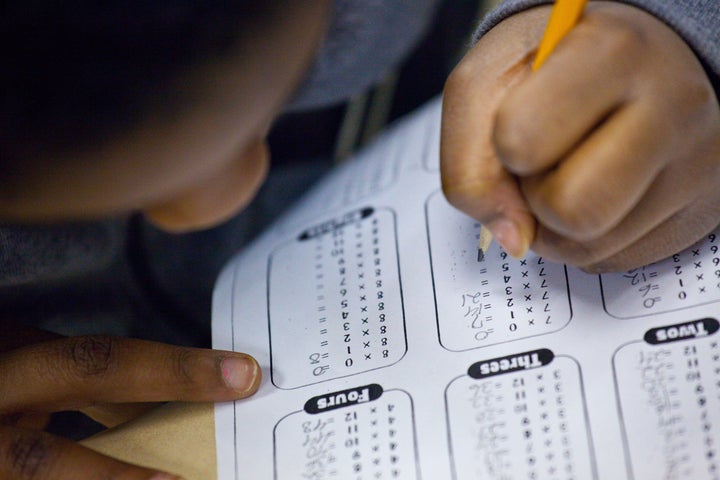
Millions of children in America are denied the opportunity to receive a fair and high quality education. In March, the U.S. Department of Education released new information showing that children of color face harsher discipline, have less access to rigorous course offerings, and are more often taught by lower paid and less experienced teachers.
Inequities in funding and educational resources place poor children in low-performing schools with inadequate facilities and often ineffective teachers. Practices such as tracking, grade retention, out-of-school suspensions, expulsions, and one-size-fits-all zero tolerance policies continue to contribute to the discouragement, disengagement, and eventual dropout of countless children in America to their detriment and to all of us who need a competitive future workforce. Instead of serving as “the great equalizer,” American public education is serving as a portal to the cradle-to-prison pipeline for millions of poor children of color, stunting their lives by school dropouts, arrests, and incarceration. The struggle to make sure a quality education is available to every child -- and not just a privilege for a few -- is the unfinished and critical business before the nation for it will determine America's future place on the global stage in a rapidly changing competitive world.
The 2009-2010 Department of Education Civil Rights Data Collection survey, the most expansive of its kind, covered 85 percent of the nation’s students and was the first release of this crucial federal data since 2006 when it was suspended by the Bush Administration. The results from the schools surveyed show public school systems where Black students represented 18 percent of students but 46 percent of those suspended more than once and 39 percent of those expelled. One in five Black boys and more than one in 10 Black girls received an out-of-school suspension compared to nine percent of Hispanic boys and four percent of Hispanic girls and seven percent of White boys and three percent of White girls. Disabled students were more than twice as likely to receive one or more out-of-school suspensions. One in eight students in the study reported having a disability and 18 percent of those students were Black boys. Black and Hispanic students represented more than 70 percent of those involved in school-related arrests or referrals to law enforcement -- an astonishing number that requires rigorous examination of the reasons why and action to change unfair racial practices in the application of discipline.
Children of color were also at a disadvantage in access to academic opportunities. Fifty-five percent of the low-minority high schools surveyed offer calculus but only 29 percent of high-minority high schools do. Similarly, 82 percent of low-minority schools offer Algebra II compared to 65 percent of the high-minority schools. Black and Hispanic students represented 44 percent of the students surveyed but only 26 percent of students in gifted and talented programs and were overrepresented when it came to repeating a grade. Across all grades, Black students were nearly three times as likely and Hispanic students were twice as likely as White students to be retained. More than half of all fourth graders retained in the reporting districts were Black and although Black students were only 16 percent of middle school students surveyed, they were 42 percent of those who repeated a grade.
Teacher experience and salaries varied widely. In schools with the highest Black and Hispanic enrollment, 15 percent of teachers were in their first or second year in the profession compared with eight percent of teachers in schools with the lowest minority enrollments. And teachers in high-minority elementary schools were paid on average $2,251 less a year than their colleagues in low-minority schools in the same district.
The Department of Education, and its Office for Civil Rights, is to be applauded for reinstating this crucial data collection survey and creating an extensive data tracking system. But that is just one crucial step. It’s time for all of us to use these numbers as a spring board for robust examination of and discussion about school discipline policies and practices and how they are contributing to school dropouts and the school to prison pipeline, and systematic and sustained action where required.
We all must support strong, consistent and fair discipline policies in our schools and classrooms where learning can occur for all children. At the same time we must raise important questions about how to make those policies work for children of color and all children, rather than against them. Why are so many children being suspended for offenses that used to result in a trip to the principal’s office? Do principals and teachers have too much discretion in deciding who should be suspended or expelled? Is there a need for rethinking and greater clarity about the range of nonviolent offenses that can result in suspensions or expulsions? Should children be suspended for nonviolent offenses like truancy and tardiness? I have never understood what good it does to put a child out of school for not coming to school. Are our young inexperienced teachers getting enough training in classroom management? Are teachers getting the cultural competence training needed to understand and address the behavior of all their children? Do policies require that a child’s parent or caregiver be notified before a child is excluded from school? Or is the child sent to the streets without the parents’ knowledge?
As Education Secretary Arne Duncan correctly said about his department’s findings, “The power of the data is not only in the numbers themselves, but in the impact it can have when married with the courage and the will to change. The undeniable truth is that the everyday educational experience for many students of color violates the principle of equity at the heart of the American promise. It is our collective duty to change that.”
